I opened my inbox one morning and saw a lead notification from the day before. It was a strong lead, a perfect fit for our ICP. But no one had followed up. No meeting was booked, no message sent. By the time we noticed, the lead was gone. It wasn’t the first time. Our process made it easy for things to slip through. Everything was manual, tracking was scattered, and we were spending more time on spreadsheets than actually moving leads forward.
That moment made us stop and rethink how we were working. If we wanted to grow, we needed a system we could trust. This is how we rebuilt our lead qualification process and changed the way we work.
What Was Broken in Our Lead Process
Here’s how things worked before we made the switch.
When someone filled out our website form, the lead details landed in our inbox. From there, we copied the information into a Google Sheet, which served as our CRM. Then, the data team stepped in to manually enrich the lead with details like company name and LinkedIn profile.
Once that was done, I had to check if the lead had booked a meeting or needed a follow-up. It sounds simple, but in practice, it was anything but. We were constantly checking emails, calendars, and spreadsheets trying to stay on top of things while juggling everything else. Sometimes, I followed up too late, and the lead had already moved on. We tried improving it by keeping better notes and setting reminders, but the process was still entirely manual. There was no real-time visibility. No single source of truth. No consistent way to know whether a lead had booked a meeting or even shown up. During a routine catch-up, it became clear that one lead hadn’t been enriched properly. That’s when the question came up:
“In a time when automation and AI are widely used, why are we still doing this by hand?”
That was the moment we realized we couldn’t keep working like this. Something had to change.
The Shift: Building a Smarter Workflow
We took a step back and mapped out the entire lead flow from start to finish. The goal was to automate everything, from the moment someone filled out a form to the final follow-up, and to make sure each stage, from MQL to SQL, was tracked without any manual work. We started building the workflow using Make, the tool we use for most of our automations.
Step 1: Integrating Form Submissions with Slack
We began by connecting our website form to Slack. Now, whenever someone fills out the form, a lead notification appears directly in our Slack channel. That became our starting point for the workflow. It removed the need to check emails and made sure we never missed a lead.

Step 2: Extracting the Email Using a Text Parser
Next, we use a text parser to pull out just the email address from the form data. The email is important because it's the one detail we can consistently use across tools to check bookings, find LinkedIn profiles, and track the lead through the funnel.
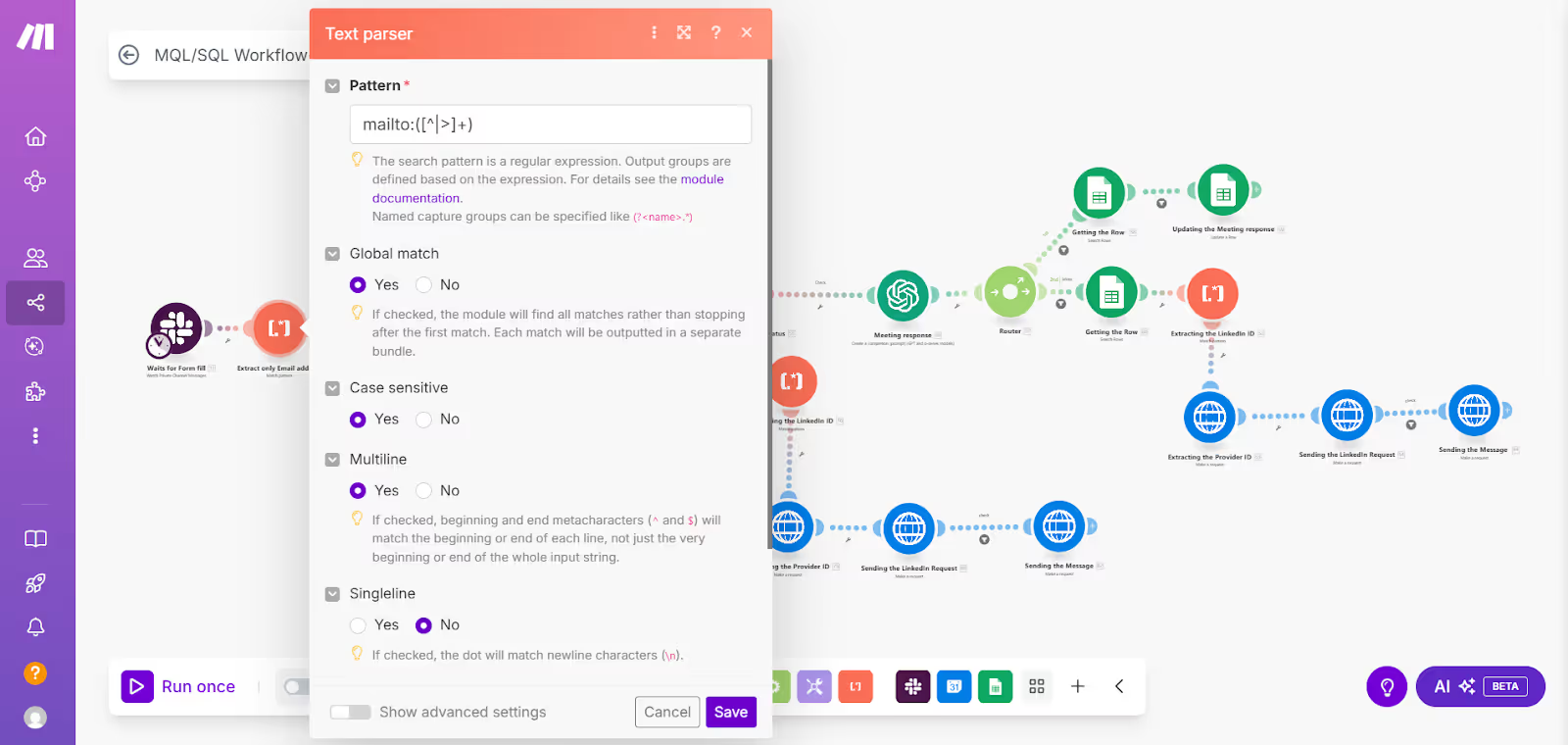
Step 3: Checking Calendar for Booked Meetings
We integrated my calendar into the workflow. The automation would now check whether the lead had booked a call with me based on the email ID.
- If no meeting was booked → the lead was tagged as an MQL (Marketing Qualified Lead)
- If a meeting was booked → the lead was moved to SQL (Sales Qualified Lead).
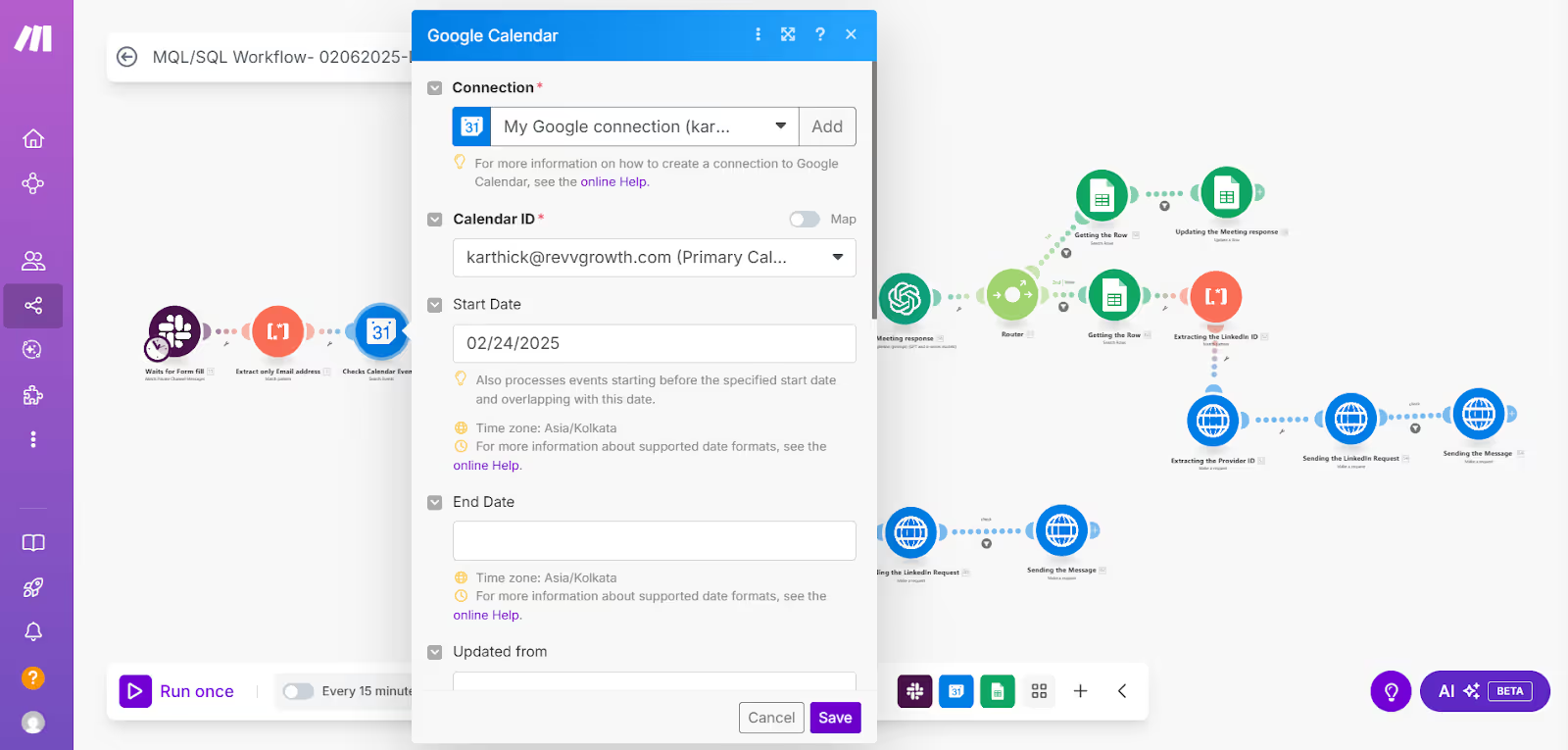
Step 4: Updating the CRM Automatically
Once identified, the automation created a new row in our Google Sheet CRM and tagged the lead with the appropriate stage (MQL or SQL). This eliminated the copy-pasting entirely.
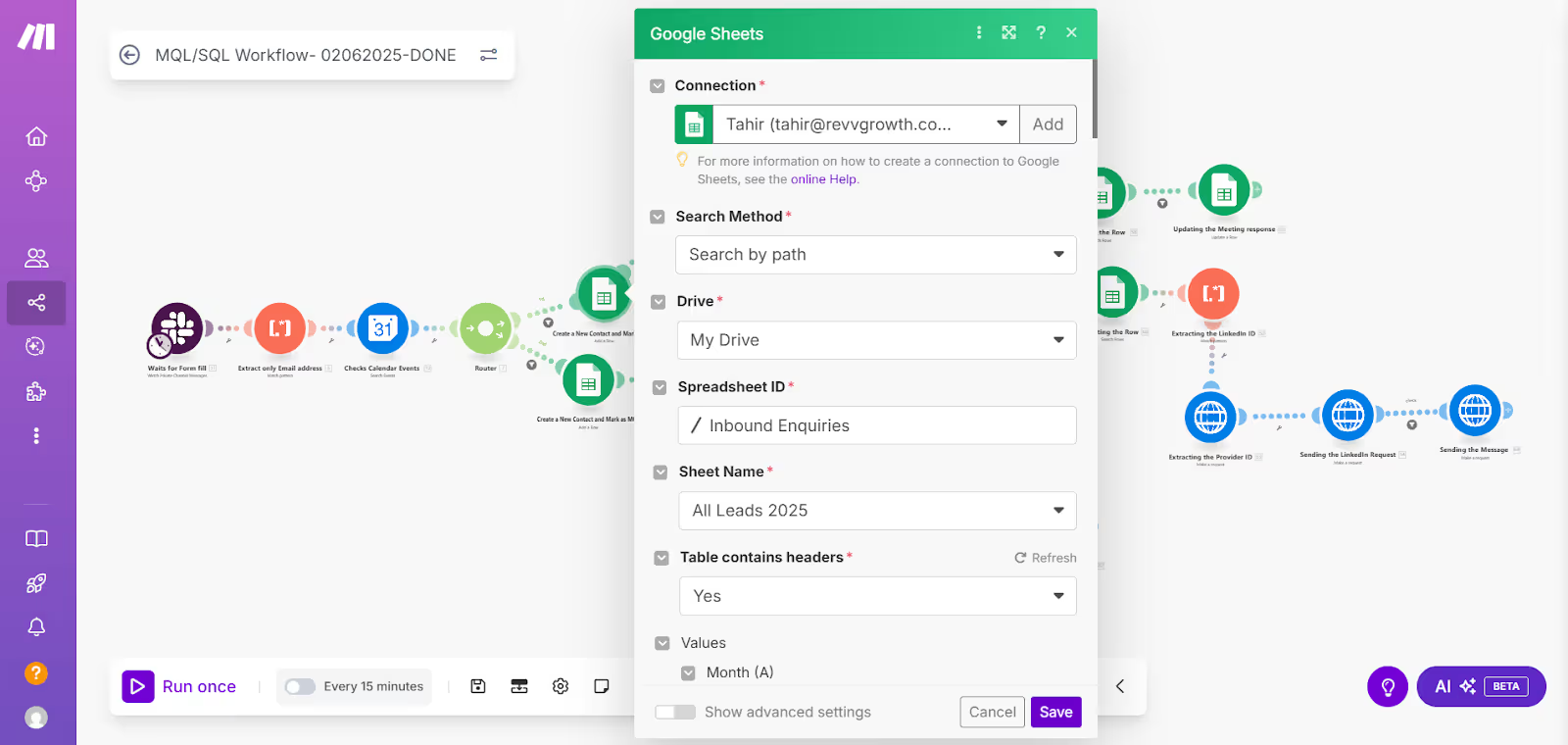
Step 5: Enrichment & LinkedIn Follow-Ups
If the lead didn’t book a meeting, the data team would enrich the row by adding the LinkedIn URL manually. Only leads with valid LinkedIn URLs went further.
Once the URL was available, Unipile came in. The automation would fetch the LinkedIn profile and send a custom connection request:
“Hey, saw you filled out our form but didn’t book a call. Let’s connect if you’re still interested.”
If we were already connected, it would just send a message instead.
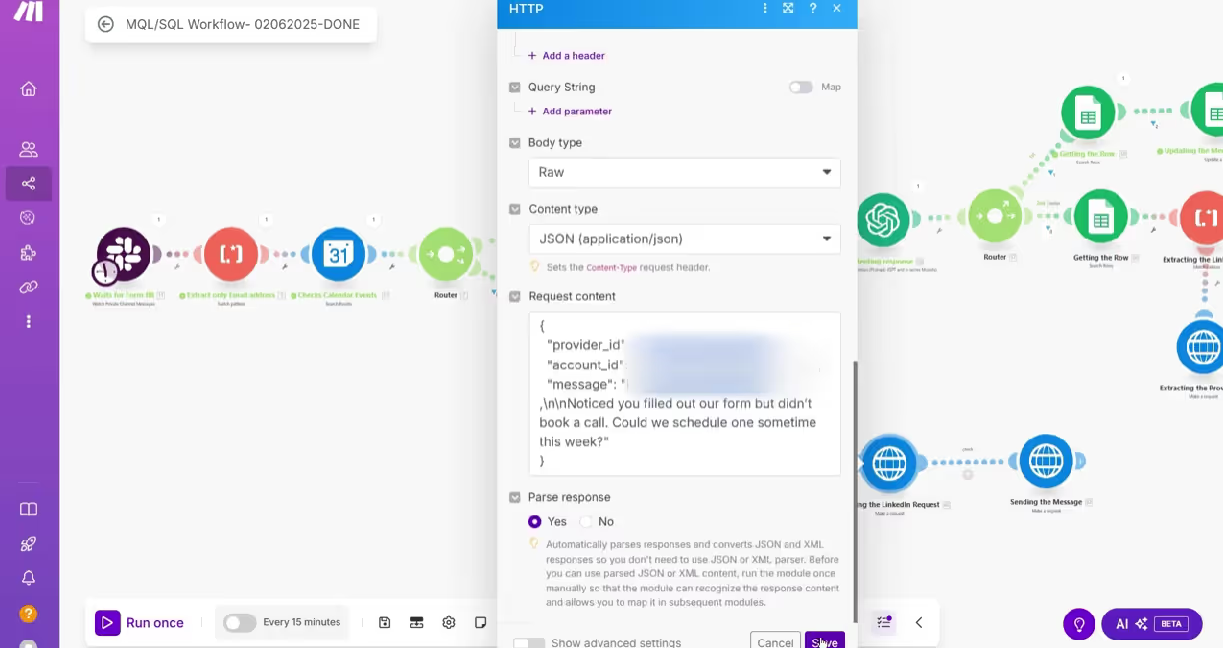
Step 6: Validating the Meeting Outcome with Fireflies
Just because a meeting was booked didn’t mean the lead was truly sales-qualified, so we added one more step. We used Fireflies to check whether the meeting actually took place. If it did, Fireflies generated a summary. If not, there was no summary. We connected this logic to Make and used ChatGPT to confirm whether the summary reflected a real conversation. If the meeting had happened, the lead was marked as an SQL and the Fireflies link was added to the CRM. If it hadn’t, the lead stayed as an MQL and the LinkedIn follow-up was triggered again.
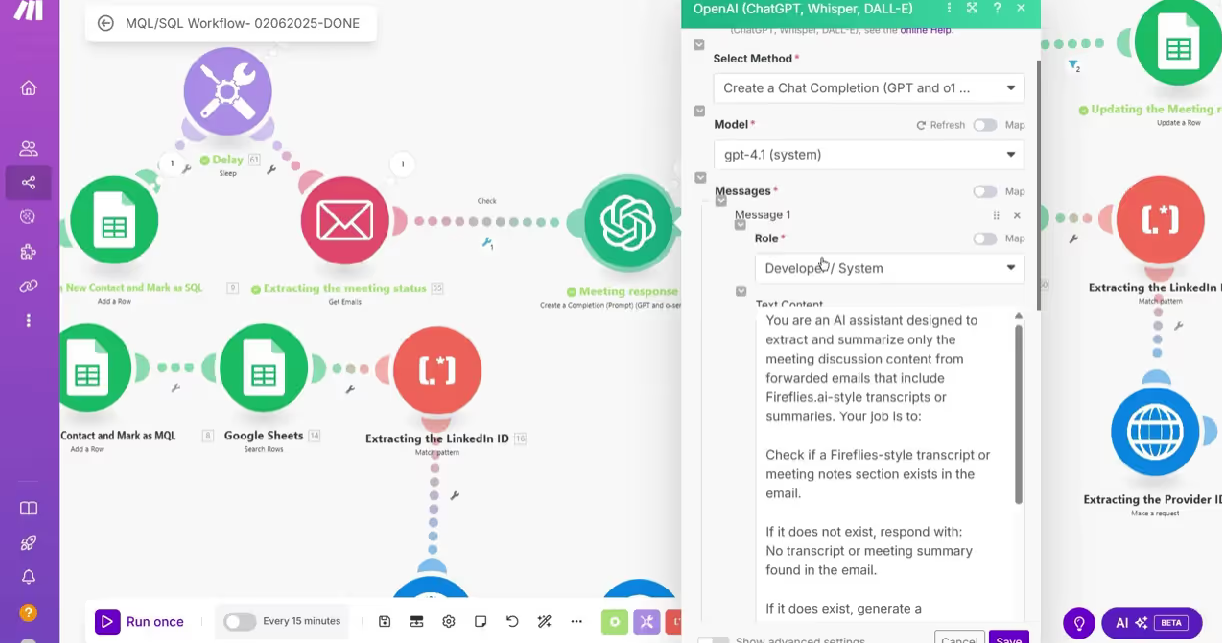
What Changed After the Automation
The impact was immediate:
- Time saved: No more email checking, manual copy-pasting, or back-and-forths
- Better tracking: Every lead now has a clear, auditable trail
- Smarter follow-ups: LinkedIn messaging is personalized and timely
- Cleaner CRM: Only valid, enriched leads move forward
- Conversion bump: Our MQL to SQL conversion rate jumped from 15% to over 21%
And let’s be honest, it just feels better. No one's chasing spreadsheets anymore. Everyone knows what stage a lead is in, and what needs to happen next.
Can This Work for Other SaaS Teams?
This setup isn’t just useful for us. Any SaaS team handling inbound leads, form submissions, or qualification steps can benefit from it. The same workflow can be used in sales pipelines, customer onboarding, demo requests, or event follow-ups. As long as there’s a clear process in place, and a flexible tool like Make, it can save a lot of time and effort.
Final Takeaways
If you're still manually tracking leads, stop. Here’s what I’ve learned through this process:
- Automations don’t just save time, they eliminate ambiguity.
- Your CRM is only as good as the data you feed into it, clean it up with logic and ownership.
- Slack is a great starting point for real-time visibility.
- Every automation should start from a real-world bottleneck, not just a fancy idea.
At Revv Growth, this shift has changed how we think about operational efficiency. It’s not just about scale, it’s about sanity.
Want to simplify your lead qualification process?
We built this workflow to cut down on manual work and improve conversions. If you’re exploring automation for your GTM or inbound funnel, feel free to reach out or connect with me on LinkedIn. Always happy to share what’s worked for us and how you can adapt it to your team.
— Karthick Raajha
Founder, Revv Growth
FAQs
.svg)
.avif)

.svg)
.avif)
.avif)
.avif)
.webp)